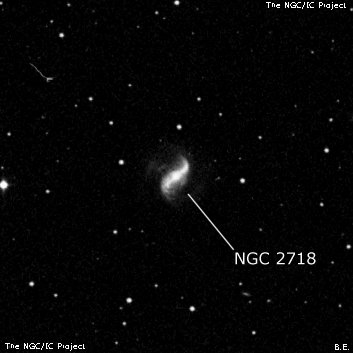
William Herschel discovered NGC 2718 = H II-557 = h542 on 24 Mar 1786 (sweep 543) and recorded "F, mE, unequally bright, 3' long, 1' broad." John Herschel only gave a very rough NPD and noted "F; pL; R." (25 Dec 1827, sweep 116) In the GC, he included h542 and his father's H II-557 as separate entries with the comment, "The descriptions are irreconcileable, and they must be two distinct nebulae..." But, Dreyer "looked carefully for other neb near it, found none." on 18 Mar 1876 with the 72" and combined the two GC entries into NGC 2718.
400/500mm - 17.5" (3/29/89): fairly faint, moderately large, oval NW-SE, bright core, stellar nucleus. Surrounded by three mag 14.5 stars 1.6' ENE, 1.4' N and 1.9' W of center.
600/800mm - 24" (4/13/18): at 375x; bright, large, overall roundish, contains a bright elongated "bar" oriented NW-SE (face-on barred spiral), small bright core with a stellar nucleus. The halo is quite a bit fainter and seems slightly elongated or oval. Surrounded by three similar stars; a mag 14.8 star lies 1.4' N, a mag 14.4 star 1.7' E and a mag 14.6 star 1.9' W. Located 55' NE of mag 3.1 Zeta (16) Hydrae.
UGC 4703, located 5.4' WNW, appeared faint, small, round, 18" diameter, low even surface brightness. Too faint for any details; just a dim glow [V = 15.5]. This galaxy is an interacting pair with tidal bridge, but the companion was too faint to detect. NGC 2718, at 180 million light-years distant is similar to the Milky Way — with two dwarf-galaxy satellites UGC 4703) like the Magellanic Clouds.
Notes by Steve Gottlieb